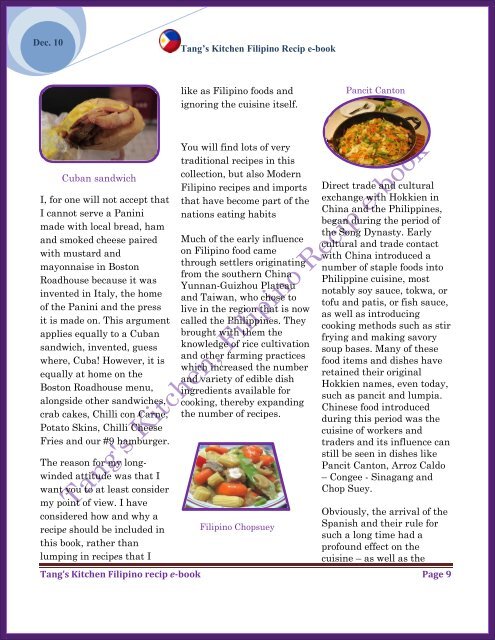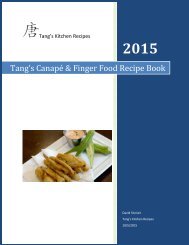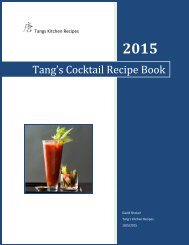TANG’S KITCHEN FILIPINO RECIP
A full sized cookbook featuring more than 150 recipes
A full sized cookbook featuring more than 150 recipes
Create successful ePaper yourself
Turn your PDF publications into a flip-book with our unique Google optimized e-Paper software.
Dec. 10<br />
Tang’s Kitchen Filipino Recip e-book<br />
like as Filipino foods and<br />
ignoring the cuisine itself.<br />
Pancit Canton<br />
Cuban sandwich<br />
I, for one will not accept that<br />
I cannot serve a Panini<br />
made with local bread, ham<br />
and smoked cheese paired<br />
with mustard and<br />
mayonnaise in Boston<br />
Roadhouse because it was<br />
invented in Italy, the home<br />
of the Panini and the press<br />
it is made on. This argument<br />
applies equally to a Cuban<br />
sandwich, invented, guess<br />
where, Cuba! However, it is<br />
equally at home on the<br />
Boston Roadhouse menu,<br />
alongside other sandwiches,<br />
crab cakes, Chilli con Carne,<br />
Potato Skins, Chilli Cheese<br />
Fries and our #9 hamburger.<br />
The reason for my longwinded<br />
attitude was that I<br />
want you to at least consider<br />
my point of view. I have<br />
considered how and why a<br />
recipe should be included in<br />
this book, rather than<br />
lumping in recipes that I<br />
You will find lots of very<br />
traditional recipes in this<br />
collection, but also Modern<br />
Filipino recipes and imports<br />
that have become part of the<br />
nations eating habits<br />
Much of the early influence<br />
on Filipino food came<br />
through settlers originating<br />
from the southern China<br />
Yunnan-Guizhou Plateau<br />
and Taiwan, who chose to<br />
live in the region that is now<br />
called the Philippines. They<br />
brought with them the<br />
knowledge of rice cultivation<br />
and other farming practices<br />
which increased the number<br />
and variety of edible dish<br />
ingredients available for<br />
cooking, thereby expanding<br />
the number of recipes.<br />
Filipino Chopsuey<br />
Direct trade and cultural<br />
exchange with Hokkien in<br />
China and the Philippines,<br />
began during the period of<br />
the Song Dynasty. Early<br />
cultural and trade contact<br />
with China introduced a<br />
number of staple foods into<br />
Philippine cuisine, most<br />
notably soy sauce, tokwa, or<br />
tofu and patis, or fish sauce,<br />
as well as introducing<br />
cooking methods such as stir<br />
frying and making savory<br />
soup bases. Many of these<br />
food items and dishes have<br />
retained their original<br />
Hokkien names, even today,<br />
such as pancit and lumpia.<br />
Chinese food introduced<br />
during this period was the<br />
cuisine of workers and<br />
traders and its influence can<br />
still be seen in dishes like<br />
Pancit Canton, Arroz Caldo<br />
– Congee - Sinagang and<br />
Chop Suey.<br />
Obviously, the arrival of the<br />
Spanish and their rule for<br />
such a long time had a<br />
profound effect on the<br />
cuisine – as well as the<br />
Tang’s Kitchen Filipino recip e-book Page 9




